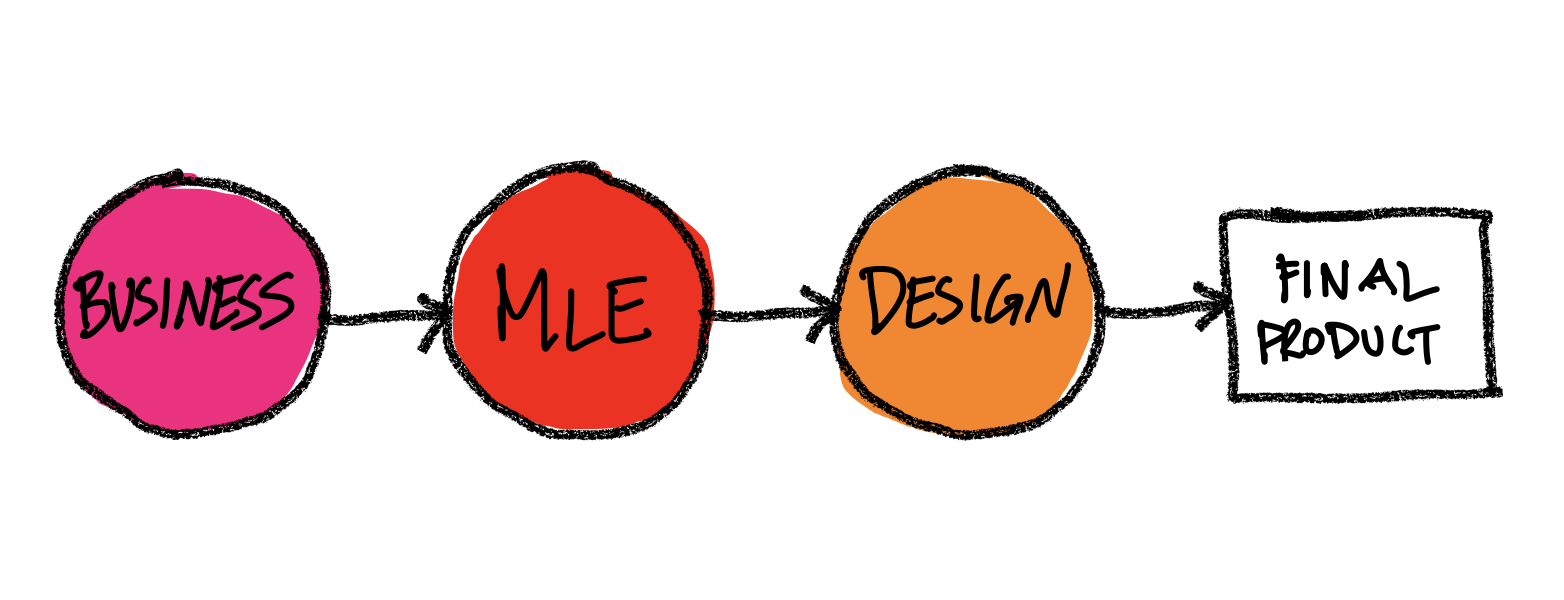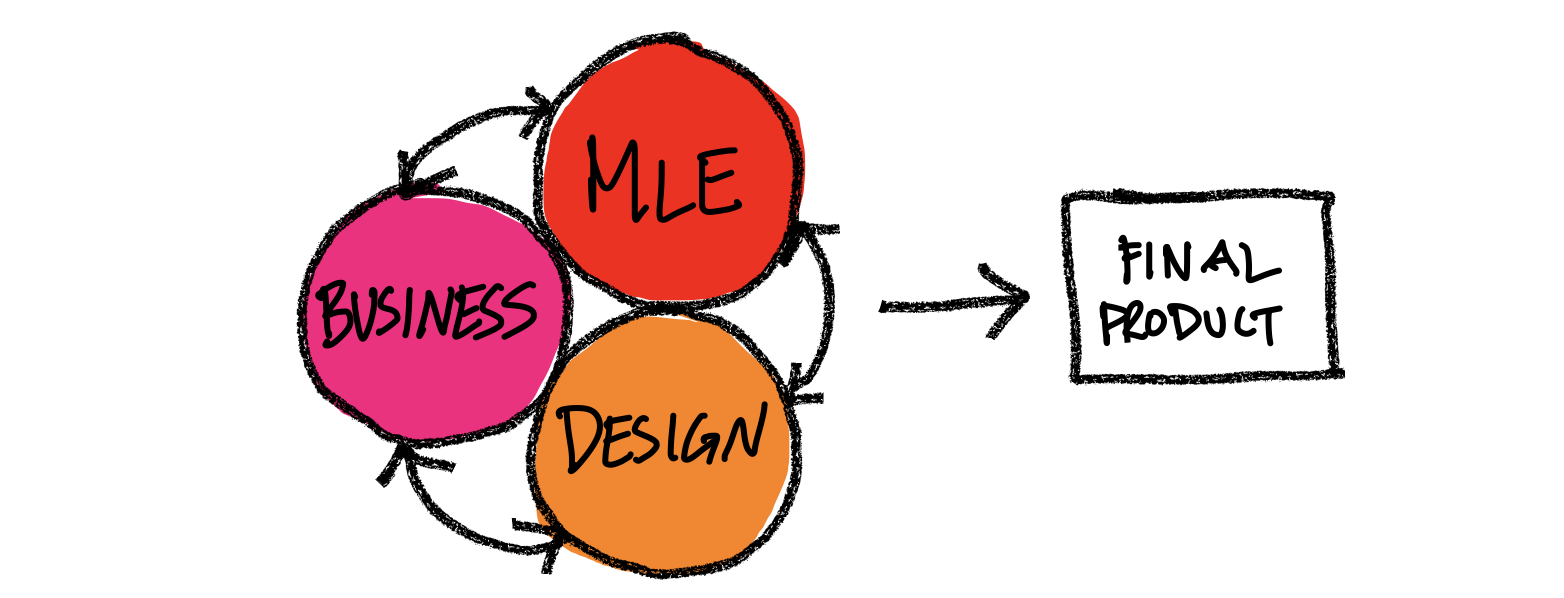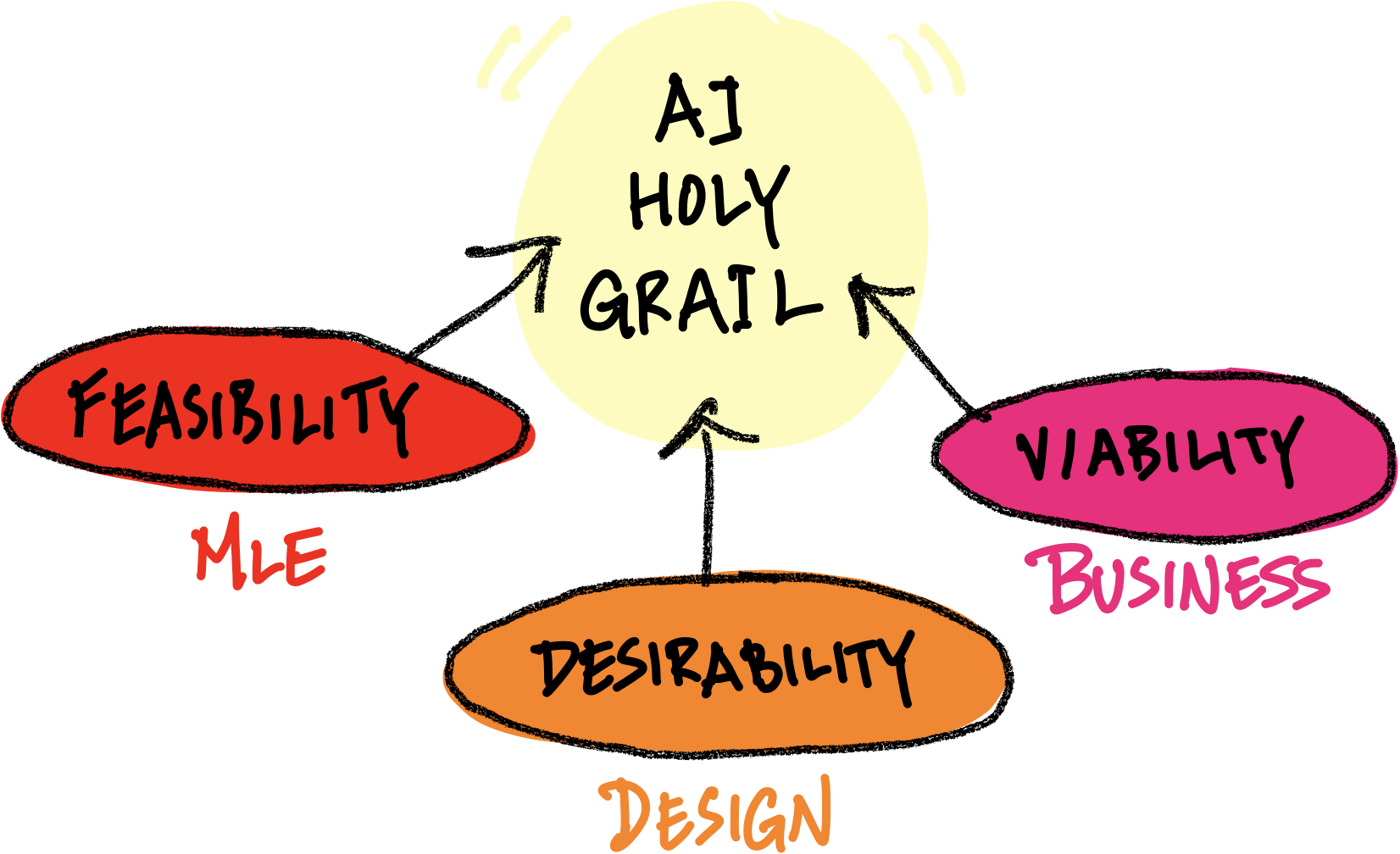💡 ML is Better with Business and Design
TL;DR: In a world quickly immersed in AI, a multidisciplinary AI design studio composed of business strategists, ML engineers, and designers could be just what we need to create pioneering AI products that are desirable, technically feasible, and financially viable.
The “assembly line” ML development
Traditionally, the field of ML engineering (MLE), due to its data and engineering intense nature, mostly sits outside of the business decision-making and product design processes.
The only times when interaction happens is when there is a new ML feature/product request, or when the product is finished and ready to hand off. In a way, the ML product lifecycle follows sort of an “assembly line” model, where business hands the product roadmap to MLE teams to implement the features (“We did all the big thinking; please make our idea a reality.”), which is then passed to design team to polish (“We did all the big thinking; please make our idea look pretty.”). The final product is then shipped out to the users.
 Of course, the process is not completely linear, as the product usually goes through multiple iterations via an agile process to refine and improve the product. But overall there are pretty distinct handoff points between each business unit in a sequential manner.
Of course, the process is not completely linear, as the product usually goes through multiple iterations via an agile process to refine and improve the product. But overall there are pretty distinct handoff points between each business unit in a sequential manner.
I guess as companies grow in size, over time this model of assembly line innovation just naturally settled, maybe because it follows the path of least resistance. But just because it’s how things are done before doesn’t mean it’s the best way.
I see several main issues with this approach:
- Feedback cycle is slow. Even though agile process is meant to shorten the feedback cycle between product development and product release, the fact that there is information egress between business units means there are inevitable costs in time associated with inter-team communication.
- The risk of misalignment. Because teams only communicate periodically, there is a high risk of miscommunication. like a bad game of charade that begins with one ML product idea but ends with a completely different product. This is especially relevant for ML development because ML concepts and capabilities are oftentimes abstract, so it’s hard to align on its functionalities.
- Expert knowledge is wasted. Each business unit have domain-specific insights that can contribute to the overall product direction and implementation, but when the lifecycle follows a linear flow, those expert knowledge miss the opportunities to surface themselves at the relevant times.
- Top-down directives reduce engagement. When people are asked to do something without clear explanation or the chance to provide input, they tend to not trust the process and aren’t as willing to buy into the effort, because top-down directives lack both intellectual and emotional recognition.
The case for “cellular” ML development
To better deliver business value using AI, the ML team should be much more multidisciplinary, with tighter integrations between business, ML engineering, and design. They should form a small autonomous unit — like a cell — that can take a product or feature from ideation to production quickly, with minimum information egress cost.
 Why is having this blended composition beneficial for ML product development? I’d say it’s because right now the ML field is at the edge of something technologically new, exciting, and yet still “raw.” In Kevin Bethune’s book Reimagining Design: Unlocking Strategic Innovation, he mentioned the feeling of being at the forefront of an industry and working on new products,
Why is having this blended composition beneficial for ML product development? I’d say it’s because right now the ML field is at the edge of something technologically new, exciting, and yet still “raw.” In Kevin Bethune’s book Reimagining Design: Unlocking Strategic Innovation, he mentioned the feeling of being at the forefront of an industry and working on new products,
In the pursuit of anything new, we tend to navigate a period that I will describe as the fuzzy front end. It’s simply a period of ambiguity. As a metaphor, the image of a nebula emerges in my mind, a cloudy chasm in space that gives birth to stars—or to new ideas, in this case. The answer that will drive the genesis of a new start-up or a new growth endeavor for a large enterprise is never immediately clear. We sit at the fuzzy front end of the opportunity funnel. We should expect, and even embrace, the grey area that is natural as we approach our work.
With the explosion of generative models that have emerged in the last few months and the immense potential of the technology, I feel the ML field is precisely at this “fuzzy front end of the opportunity funnel.” There are lots of unknowns, from the technological, societal, and user level perspectives in terms of how this technology will unfold.
When faced with such a fuzzy future, a diversity of thoughts is needed to cast a net wide to discover and converge on an AI opportunity, and then ideate to converge on the best bets for investment. As an insight percolates into opportunities, a multidisciplinary team can evaluate the ideas for desirability, viability, and technical feasibility before moving forward to development.

- Desirability asks, “Does the AI technology have meaning and relevance to someone?” This can be answered by the designers through UX research and design thinking approaches.
- Feasibility asks, “Can we actually figure this out and translate the idea into deployable models?” This can be answered by the ML engineers through customizing model architectures and fine-tuning approaches.
- Viability asks, “Can the AI feature make money and strategically win in the marketplace?” This can be answered by the business folks through competitive analysis and analytics.
Why not create an AI design studio?
A good blueprint for creating such an autonomous ML organization can be found in the various design studios that have emerged in the past few decades. Renowned design firms like IDEO, Pentagram, frog, LUNAR, or Apple’s IDg, have all made significant impact across various industries, from industrial design to management consulting to advertisement and organizational design.
A common thread between them is that they all consisted of interdisciplinary members with expertise in business, design, and technology. This highly integrated and collaborative modus operandi seems to offer real value and is attracting big companies’ attention, as evident by the trend of big brands acquiring design studios or creating their own in-house teams.
So as AI emerges from the haze as the next digital frontier, why not create “AI design studios” to tackle the upcoming challenges that will confront us in an accelerated future?
The pace of AI advancement is way faster than that of previous innovations. From the technology POV, R&D is still actively exploring how to align models with human intentions, and where limitations exists. From the design POV, the UI/UX of the whole AI experience is still being figured out (does chat provide the best affordance interacting with AI systems?). From the business POV, businesses are still strategizing how to distill buyer value using AI features. At a higher level, the societal, political, and technological ramifications aren’t clear.
There are so many important challenges rushing towards us as a society, and I feel that an AI design studio is well-suited to respond to them in an agile, inclusive, and human-centered manner.
Currently, AI startups such as Anthropic, Cohere, and OpenAI are giving off that AI design studio vibes, combining R&D with design and making a viable business. Of course, we are still in the very early phase of AI in the story of humankind, so I’m interested to see where all this goes.